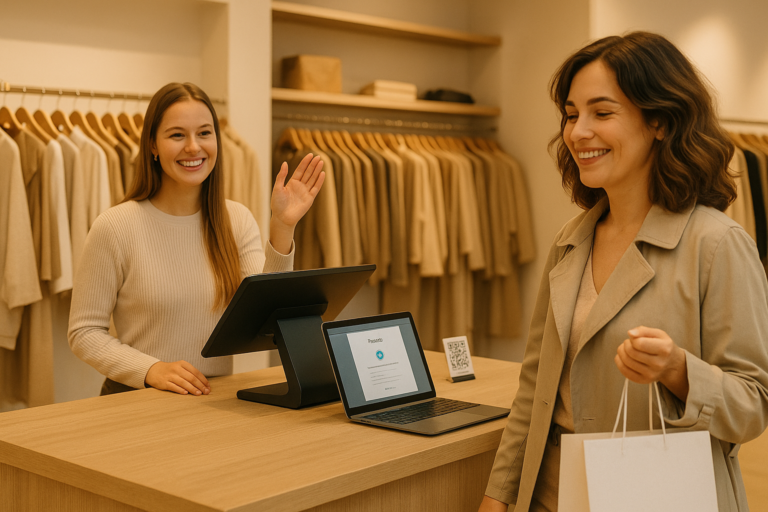Over the past few years, “retail media” has evolved significantly. Originally focused on e-commerce, it now encompasses physical stores as well. Often called digital advertising’s third wave, it is one of the most powerful tools in a marketer’s arsenal today.
No wonder retail media generated £3 billion in revenue in the UK in 2023, achieving this milestone in just seven years—faster than both social media (13 years) and search engines (17 years).
This blog will delve into the different types of retail media, explore why brands are increasingly turning to it, and highlight innovative ways to integrate retail media with offline stores. Additionally, we will discuss digital receipts, a sustainable and cost-effective retail media option.

Image Source
What is retail media?
Retail media refers to advertising that appears within a retailer’s environment, whether online or in physical stores. It creates a unique opportunity for brands to target consumers at or near their point of purchase, or point of choice between competing brands or products.
This includes digital displays, in-store audio ads, product sampling, and online ads on websites.
The concept of retail media isn’t new, but its implementation has evolved significantly. With the advent of advanced data analytics, retailers can now deliver highly targeted ads based on shopper behaviour and preferences.
To put the impact of retail media into perspective, digital retail media advertising in the UK reached £3.4 billion in 2022. It’s projected to grow at a 23% annual rate, hitting £7.88 billion by 2026.
Why are brands choosing retail media?
In-store retail media helps brands reach more customers and encourages impulse buying with targeted ads. It’s a high-margin revenue stream which improves the shopping experience as well.
Brands are gravitating towards retail media for several compelling reasons.
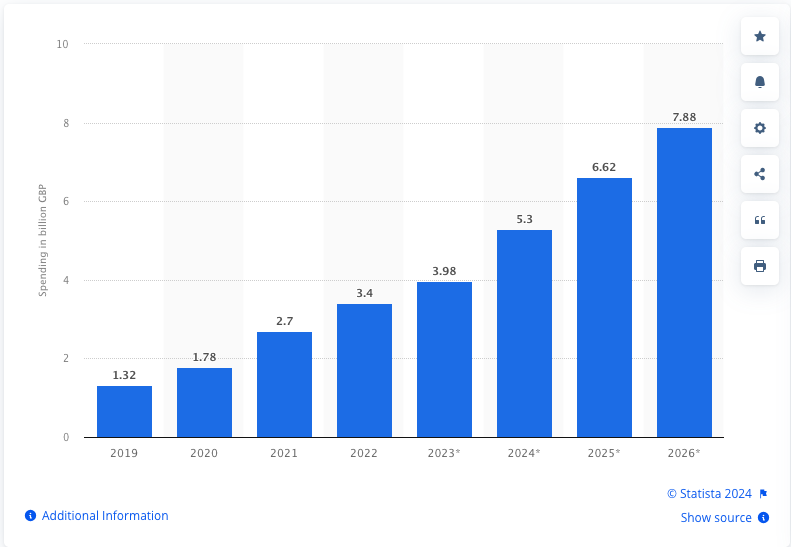
Image Source
1. It increases ad targeting efficiency
Unlike traditional channels like TV commercials and billboards, which cast a wide net, retail media targets shoppers already in a buying mindset. This focus leads to higher engagement and conversion rates.
Traditional media methods often lack precise targeting, making them less efficient. Retail media, however, places ads within the retail environment—whether online or in-store—reaching consumers at the point of purchase. This strategic placement ensures that ads are relevant and timely, significantly increasing their impact.
Retail media has evolved beyond simple shelf placements and in-store displays. It now includes digital receipts and interactive kiosks.
2. It helps personalise advertising messages
Retail media offers unparallelled personalisation capabilities. By leveraging data from shoppers’ online and offline behaviours, brands can deliver highly relevant ads that resonate with individual consumers.
For instance, a shopper who frequently buys organic products can receive promotions for new organic matcha as they shop, both online and in-store.
3. It improves the advertising campaigns’ ROI
Retail media significantly boosts the return on investment (ROI) for advertising campaigns. In-store ads can increase product sales by up to 20% due to their precise targeting. Unlike traditional ads, retail media reaches consumers when they’re ready to buy, making ads more effective.
Using shopper data, retail media delivers personalised ads, increasing relevance and conversion rates. For example, a digital sign promoting a new snack in the snack aisle can prompt immediate purchases.
Additionally, retail media provides measurable metrics, allowing brands to track ad performance and optimise campaigns in real time. This ensures efficient use of ad spend and higher ROI compared to traditional advertising methods.
4. It creates a delightful shopping experience for customers
Retail media enhances the shopping experience by offering personalised recommendations and relevant promotions tailored to each customer’s preferences and history. This targeted approach increases convenience and satisfaction by presenting timely and useful information, ultimately creating a more engaging and delightful shopping environment.
Different types of retail media
Retail media networks can include online platforms, such as a retailer’s website or app, as well as in-store digital signage and other physical touchpoints. Here’s a detailed look at the various types of retail media and their subtypes:
In-store advertising
In-store advertising involves placing promotional materials within retail spaces to influence buying decisions directly in the physical store.
1. Digital signage
Digital signages are the most commonly used retail media. These are large screens that display dynamic ads, promotions, and product information.
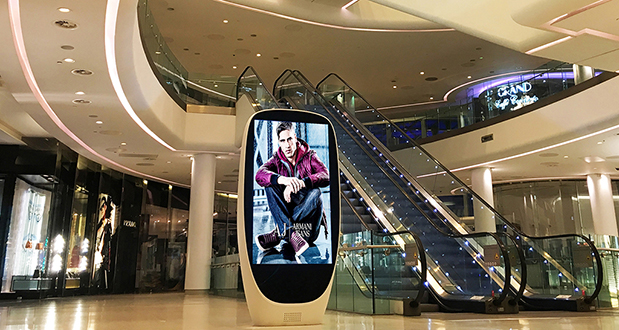
Image Source
Digital signage, such as interactive screens, enhances shopping experience by providing access to digital content and services. These screens allow shoppers to browse product catalogues, check availability, and view detailed information, making the shopping journey more informative and engaging. The screens are strategically placed throughout the shopping centre to attract and assist customers effectively.
Here’s what’s great about this digital signage:
- Uses data analytics and machine learning to offer tailored product suggestions, boosting cross-selling and upselling.
- Connects with retailers’ inventory and CRM systems for a smooth transition between online and offline shopping.
- Provides intuitive user interfaces that enrich the retail experience, leading to higher customer satisfaction.
- Ensures easy access to product information and availability, improving the overall shopping journey.
2. Point-of-sale displays
These are eye-catching displays near checkout areas that highlight new products or special offers. Point-of-sale displays are a less common yet highly effective marketing tool placed strategically near checkout areas to capture shopper attention and drive impulse purchases.
Unlike traditional shelving, these displays are designed to prominently showcase new products or special offers, making them hard to miss during the final stages of the shopping journey.
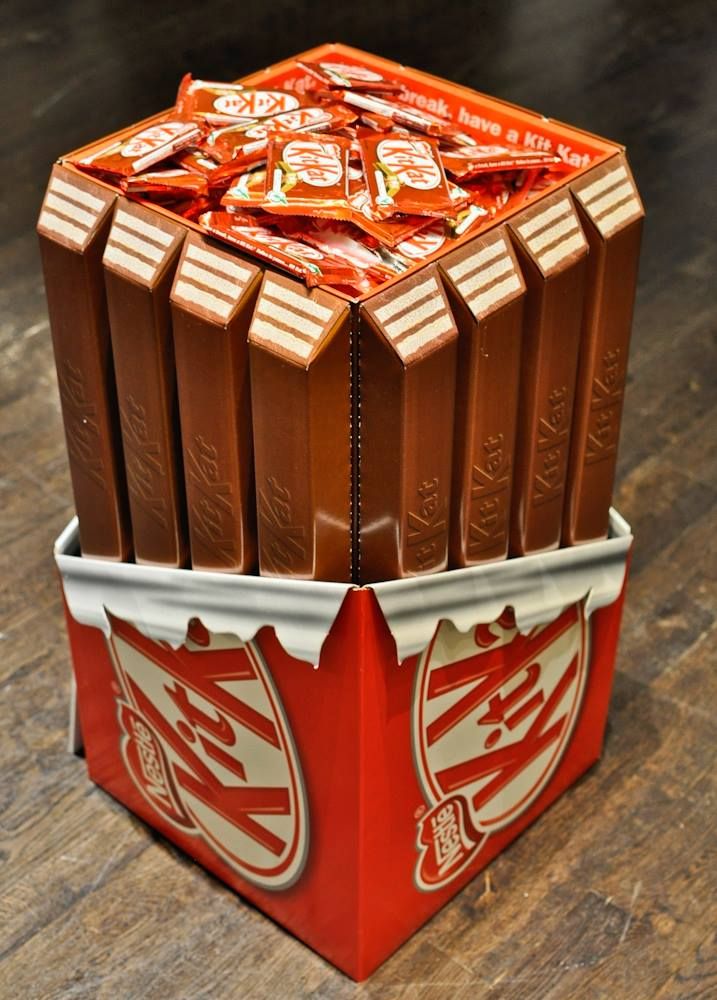
Image Source
Kit Kat uses dump bins to attract shoppers after they finish their grocery shopping, leveraging the bins’ attractive design that mirrors the product inside. These bins are perfect for products such as candy bars and small snacks that thrive on impulse buying.
Here’s what’s great about this point-of-sale display:
- Positioned strategically to attract attention at checkout points.
- Can be placed flexibly around the store without requiring dedicated shelving.
- Appeals directly to customers’ spontaneous purchasing tendencies.
3. Digital receipts
Digital receipts are a modern alternative to traditional paper receipts, delivered via email or mobile apps after a purchase. This method not only reduces paper waste but also presents a powerful opportunity for targeted marketing and customer engagement through personalised promotions.
Unlike conventional receipts, digital receipts provide brands with a direct channel to interact with customers post-purchase. They can also send tailored discounts and product recommendations based on the customer’s shopping history and preferences.

Here’s why digital receipts are a great retail media option:
- Offers a digital copy of the receipt that can be emailed or sent via Whatsapp, making returns and exchanges hassle-free.
- Encourages sign-up for loyalty programmes with immediate benefits like 25% off the first purchase.
- Allows customers to rate their experience digitally, enhancing the retailer’s reputation management efforts.
- Includes exclusive, time-sensitive promotions to incentivise repeat purchases, like “Buy 2 socks, pay for one.”
- Promotes app downloads directly from the receipt.
- Encourages following on social media and provides discounts for future visits, bridging online and offline interactions.
- Reduces paper waste.
4. In-store audio ads
In-store audio ads are announcements or promotional messages played through a store’s sound system. They’re designed to catch shoppers’ attention and influence their buying decisions in real-time.
Audio ads are straightforward for brands and retailers alike. Brands can easily create ads themselves, and retailers can use existing sound systems to broadcast these ads in-store. This approach integrates with the customer experience, as shoppers are already accustomed to hearing music and announcements.
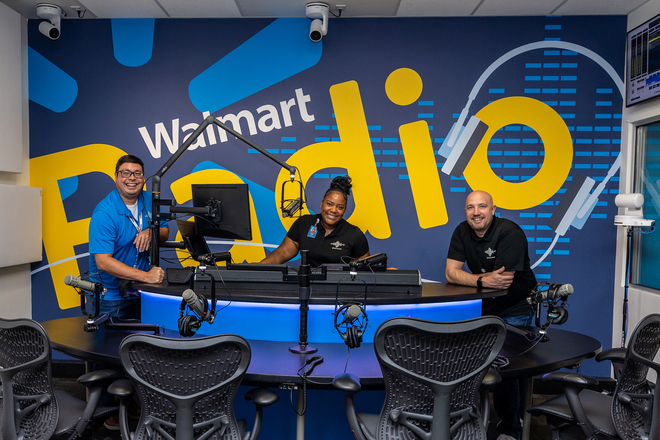
Image Source
Moreover, Walmart is pioneering the use of audio ads through its Walmart Radio network. They are offering product demos and ad placements, allowing brands to target consumers regionally or even by individual stores. This initiative represents a groundbreaking opportunity for advertisers to engage shoppers in new ways.
5. Product sampling
Product sampling involves offering consumers the opportunity to try out products for free or at a discounted price before making a purchase. This strategy aims to influence purchasing decisions by allowing potential customers to experience the product’s quality, taste, or effectiveness firsthand.
It’s commonly used in retail environments, particularly in grocery stores, health and beauty shops, and at events or festivals. Sampling helps brands create positive brand experiences, generate immediate sales, gather feedback, and potentially convert samplers into regular customers.
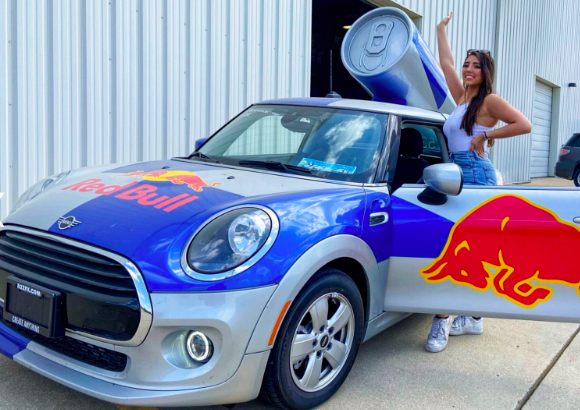
Image Source
Red Bull uses brand ambassadors called Musketeers to distribute their products across the UK through sampling. These musketeers are passionate about building partnerships and driving product trial and consumption.
6. In-store events and experiences
In-store events and experiences are designed to attract and engage customers by creating memorable interactions within retail spaces. These events can range from product launches and demonstrations to themed celebrations or community gatherings hosted in-store.
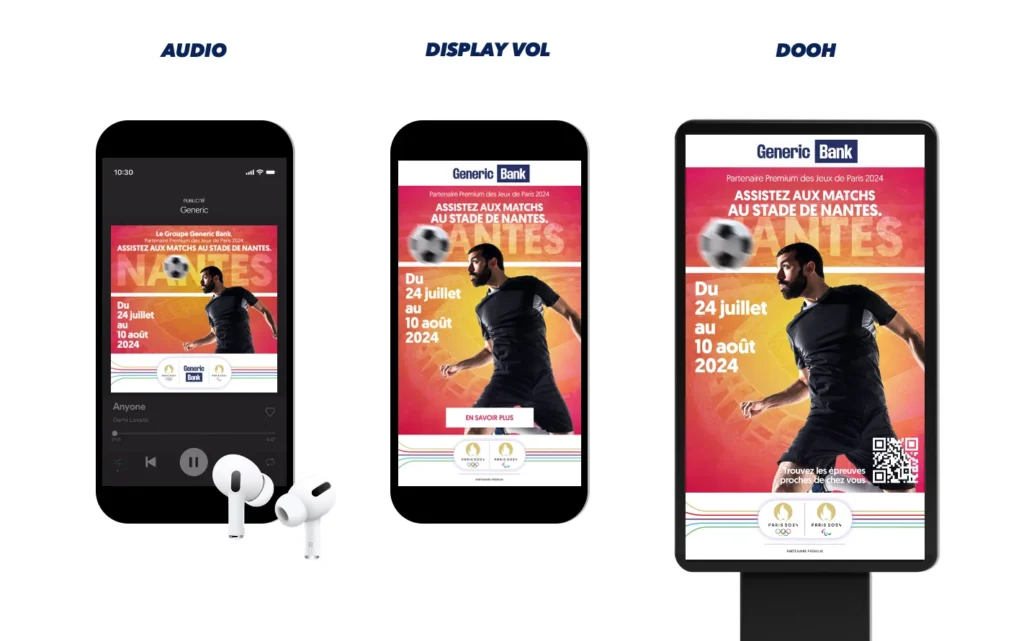
Image Source
For EURO 2024, retailers and brands can host viewing parties or themed events in their stores, like tastings of European snacks and beverages. By matching promotions with customer interests and placing related products together, such as pizza and beer, stores can improve the shopping experience and increase sales during the tournament. Effective POS displays and merchandising that disrupt the usual shopping routine can draw football fans, boost brand visibility, and gain an edge over competitors.
7. In-store touchpoints
In-store touchpoints, such as smart product assistant and store assistant, utilise QR codes or NFC tags strategically placed near products. These touchpoints aim to enhance the customer shopping experience by providing easy access to detailed digital product pages. Here, customers can explore:
- Comprehensive product details
- Assistance request options
- Recommendations for related products or services
- Availability of information across online and in-store inventory
- Virtual try-on features
- Customer reviews
- Opportunities for NFT purchases
This technology bridges the gap between physical and digital retail environments, offering customers more information and engagement options directly at the point of interest.
Online retail media
Online retail media consists of various digital advertising strategies to target and engage consumers actively shopping online.
1. E-commerce sites
Ads placed strategically on e-commerce platforms are highly effective in reaching consumers actively shopping online. These ads capitalise on the browsing behaviour of potential customers, ensuring visibility at crucial decision-making moments.
For instance, a fashion brand might invest in prominent placements on a popular e-commerce site like Amazon or ASOS, targeting fashion enthusiasts looking for the latest trends or specific apparel items.
2. Social media platforms
Social media advertising allows brands to engage with consumers based on their interests, behaviours, and demographic profiles. By leveraging detailed user data, brands can tailor ads to specific audience segments, enhancing relevance and engagement.
For example, a home decor brand may launch a focused social media campaign showcasing its products to homeowners interested in interior design trends or DIY projects.
3. Email marketing
Email marketing remains a powerful strategy for engaging directly with subscribers and promoting products tailored to their interests. Personalised email campaigns are particularly effective in driving engagement and conversions.

Image Source
In industries like fashion, activewear, sports, and home decor brands leverage email marketing to showcase new collections, announce product launches, and share inspiring content tailored to their audience’s preferences and interests.
To maximize deliverability and maintain a clean email list, brands use real-time email validation tools to filter out invalid or inactive addresses. This helps reduce bounce rates, protect the sender’s reputation, and ensure messages reach genuine, engaged recipients.
4. Affiliate Marketing
Affiliate marketing involves partnering with influencers, bloggers, or other content creators to promote products and drive traffic to retail websites. This strategy benefits both brands and affiliates by expanding reach and generating sales through trusted recommendations.
Here’s a look at Claire’s affiliate marketing programme:

Image Source
5. Loyalty Programmes
Loyalty programmes are designed to reward repeat customers with points, discounts, and exclusive offers, encouraging continued engagement and purchases. These programmes increase customer retention and foster brand loyalty by providing personalised incentives and rewards based on purchase history and engagement levels.
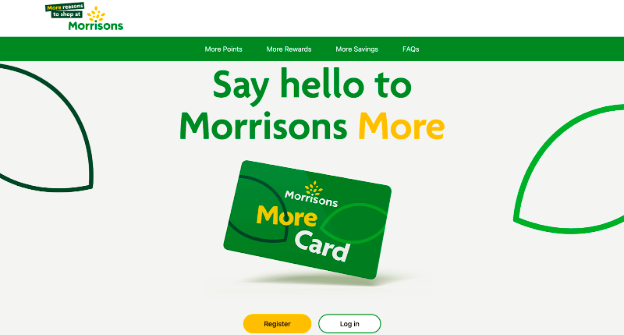
The Morrisons More loyalty programme offers customers a rewarding shopping experience through a points-based system. Shoppers earn points on selected products, fuel, and online purchases, which can be redeemed for savings. The programme also provides personalised offers and exclusive prices, ensuring customers get the most out of their shopping.
Here’s what Morrisons More is doing right in it’s loyalty programme:
- Diverse Earning Opportunities: Points can be earned on a wide range of products and services.
- Personalised Rewards: Offers are tailored to individual shopping habits.
- Exclusive Savings: Members enjoy special pricing on selected items.
- Random Rewards: Basket Bonus provides unexpected treats and discounts.
- Convenient App: The mobile app allows easy tracking of points and access to offers.
Mobile retail media
Mobile retail media involves delivering targeted advertisements and promotions through mobile devices.
1. Branded apps
Branded apps offer a direct channel to engage with consumers, providing a seamless and personalised shopping experience. Retailers use these apps to build loyalty and enhance customer interaction. For instance, Apple Pay integrates smoothly with branded apps, allowing for quick and secure payments.

Image Source
Ikea Place uses an AR feature that helps customers visualise products in their space. It exemplifies this by allowing customers to take a picture of a room in their house and virtually place Ikea furniture to see how it fits. This generates interest and guides customers when they visit the store. After selecting furniture from a printed catalogue, users place the catalogue on the floor as an anchor for the 3D image of the furniture.
2. Mobile ads
Mobile ads target users based on their location and behaviour, ensuring relevant and timely messages. These ads are designed to engage customers on their smartphones, where they spend a significant amount of their time.
Example: A coffee shop sends a mobile ad offering a discount to users who are nearby during morning hours.
3. SMS marketing
SMS marketing involves sending promotional messages directly to consumers’ mobile phones. This method ensures high open rates and quick communication.

Image Source
Flower delivery brand FLOWERBX used geo-targeting to send highly relevant shipping reminders to subscribers based on their location. Two days before the shipping deadline for Valentine’s Day orders, FLOWERBX created a sense of urgency through timely messaging (“Final Call”) in their texts.
5 ways retail media helps brands with offline stores

Image Source
Retail media provides powerful tools for brands with physical stores to optimise customer
engagement and drive sales through targeted advertising strategies. The UK is leading the charge on in-store retail media. It’s no surprise that Amazon Advertising leads the pack in this space.
A survey by DoubleVerify, which polled 4,000 marketers, found that Amazon was the top retail media network in three of the four markets surveyed: the US (51%), the UK (71%), and Germany (51%). However, other players like Walmart Connect, Target Roundel, Disney Advertising, and Lowe’s One Roof Media are also making significant strides in the industry.
Let’s take a look at how exactly retail media helps offline stores.
1. It enhances customer experience through targeted advertising
Retail media enhances customer experience by tailoring messages to individual preferences. For example, Decathlon, a France-based sports retailer, uses dynamic displays to highlight promotions and product benefits, effectively capturing shoppers’ attention. Personalised in-store ads increase relevance and engagement, making the shopping experience more enjoyable and informative.
2. It drives foot traffic to physical stores
Targeted online and mobile ads are essential in directing customers to nearby stores. Decathlon leverages location-based targeting to highlight exclusive offers and events, encouraging spontaneous visits. This strategy not only boosts store traffic but also increases sales as customers are drawn in by timely and relevant promotions.
3. It integrates your online and offline marketing strategies
Aligning digital campaigns with in-store promotions creates a seamless customer journey. Decathlon ensures consistent messaging across its online and offline channels, enhancing brand recall and encouraging both online engagement and in-store visits. This integration makes it easier for customers to transition from browsing online to purchasing in-store.
4. It increases in-store sales through personalised promotions
Using shopper data to offer personalised discounts and recommendations can significantly boost in-store sales. Decathlon tailors promotions based on purchase history and preferences, driving higher conversion rates and increasing average transaction values. Personalised promotions make customers feel valued and more likely to make additional purchases.
5. It builds brand loyalty
Implementing loyalty programmes and exclusive in-store experiences helps build brand loyalty. Decathlon rewards repeat customers with VIP events, early access to new products, and personalised rewards. These efforts foster long-term customer relationships and advocacy, ensuring that customers keep coming back.
Digital receipts: A sustainable retail media option
Digital receipts utilise a QR code or NFC tag at checkout to deliver a smart receipt directly to the mobile browser, without requiring additional marketing spend or customer opt-ins. Customers can view ads optionally and opt-in for further engagement.
This approach surpasses traditional retail media by integrating seamlessly into the customer journey without intrusive opt-ins.
Here’s how they enhance the retail experience:
- Provides helpful information per item purchased: Detailed product information and usage tips enhance the customer’s understanding and satisfaction.
- Recommends complementary and similar products: Suggestions for related items or upgrades increase cross-selling opportunities.
- Converts customers to digital offerings: Prompts to join loyalty programmes or download custom apps deepen brand engagement.
- Enables post-purchase engagement: Receipts delivered via email, wallet pass, or WhatsApp allow ongoing communication with personalised offers and updates.
Let us see how adding digital receipts to a physical store will help across the buyer journey:
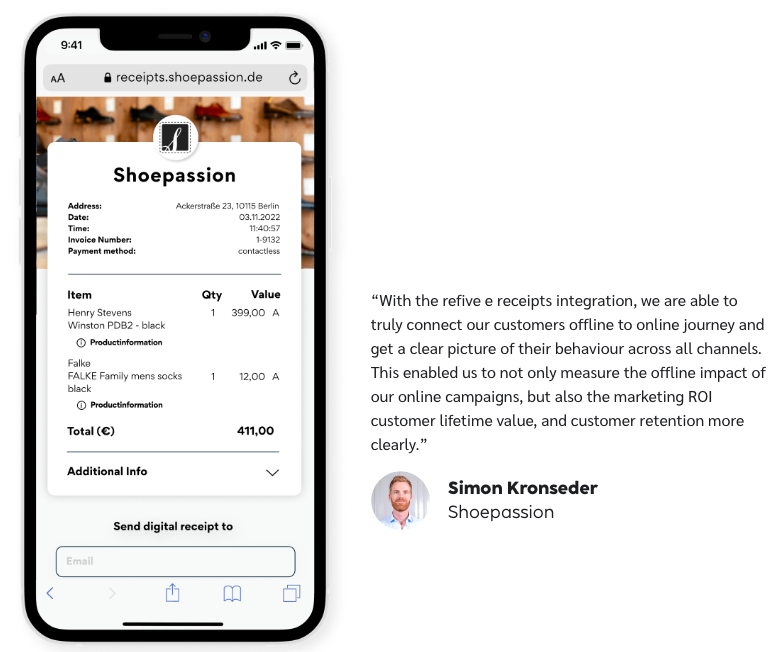
Image Source
Gusti Leder, a prominent D2C retailer, collaborated with refive to deploy digital receipts across its 29 stores in Germany, the Netherlands, and Austria. This solution, accessible via QR codes, has boosted customer engagement with features like product warranties and coupons, achieving an average engagement rate of 21% and peaking at over 40% in some locations.
Within five months, Gusti Leder has seen 2,300 newsletter signups and 2,200 feedback submissions, enhancing customer loyalty and retail experience. Explore how digital receipts are transforming Gusti Leder’s retail strategy and customer relationships in the full case study.
Ready to transform your offline store retail experience at no additional cost?
To improve in-store and post-purchase experiences, you can effortlessly upgrade to digital receipts with refive. We help retailers identify, understand and engage omnichannel customers. You can introduce sustainable digital receipts at your physical store without friction. You can then use customer data to create targeted in-store and post-purchase engagement campaigns, loyalty programs and more with your existing tech stack.
Contact us to learn more about integrating digital receipts into your retail operations to boost engagement, retention, and drive revenue.





